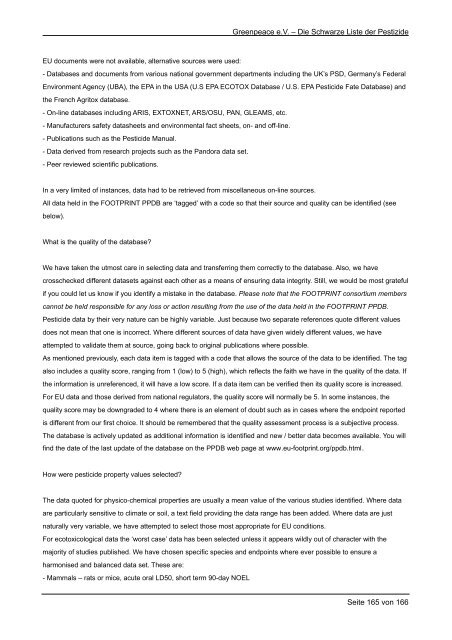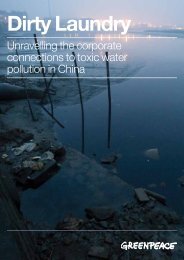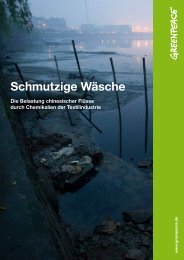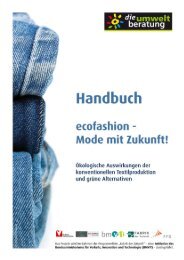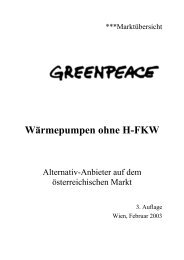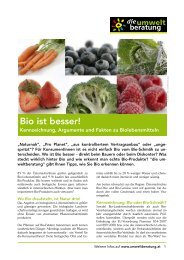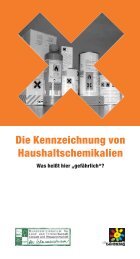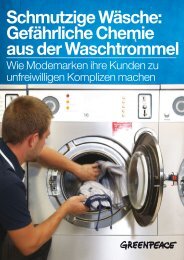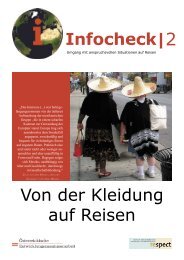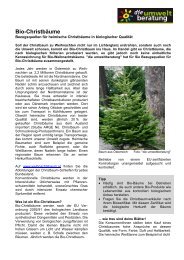Die Schwarze Liste der Pestizide - Greenpeace
Die Schwarze Liste der Pestizide - Greenpeace
Die Schwarze Liste der Pestizide - Greenpeace
Sie wollen auch ein ePaper? Erhöhen Sie die Reichweite Ihrer Titel.
YUMPU macht aus Druck-PDFs automatisch weboptimierte ePaper, die Google liebt.
EU documents were not available, alternative sources were used:<br />
<strong>Greenpeace</strong> e.V. – <strong>Die</strong> <strong>Schwarze</strong> <strong>Liste</strong> <strong>der</strong> <strong>Pestizide</strong><br />
- Databases and documents from various national government departments including the UK’s PSD, Germany’s Fe<strong>der</strong>al<br />
Environment Agency (UBA), the EPA in the USA (U.S EPA ECOTOX Database / U.S. EPA Pesticide Fate Database) and<br />
the French Agritox database.<br />
- On-line databases including ARIS, EXTOXNET, ARS/OSU, PAN, GLEAMS, etc.<br />
- Manufacturers safety datasheets and environmental fact sheets, on- and off-line.<br />
- Publications such as the Pesticide Manual.<br />
- Data <strong>der</strong>ived from research projects such as the Pandora data set.<br />
- Peer reviewed scientific publications.<br />
In a very limited of instances, data had to be retrieved from miscellaneous on-line sources.<br />
All data held in the FOOTPRINT PPDB are ‘tagged’ with a code so that their source and quality can be identified (see<br />
below).<br />
What is the quality of the database?<br />
We have taken the utmost care in selecting data and transferring them correctly to the database. Also, we have<br />
crosschecked different datasets against each other as a means of ensuring data integrity. Still, we would be most grateful<br />
if you could let us know if you identify a mistake in the database. Please note that the FOOTPRINT consortium members<br />
cannot be held responsible for any loss or action resulting from the use of the data held in the FOOTPRINT PPDB.<br />
Pesticide data by their very nature can be highly variable. Just because two separate references quote different values<br />
does not mean that one is incorrect. Where different sources of data have given widely different values, we have<br />
attempted to validate them at source, going back to original publications where possible.<br />
As mentioned previously, each data item is tagged with a code that allows the source of the data to be identified. The tag<br />
also includes a quality score, ranging from 1 (low) to 5 (high), which reflects the faith we have in the quality of the data. If<br />
the information is unreferenced, it will have a low score. If a data item can be verified then its quality score is increased.<br />
For EU data and those <strong>der</strong>ived from national regulators, the quality score will normally be 5. In some instances, the<br />
quality score may be downgraded to 4 where there is an element of doubt such as in cases where the endpoint reported<br />
is different from our first choice. It should be remembered that the quality assessment process is a subjective process.<br />
The database is actively updated as additional information is identified and new / better data becomes available. You will<br />
find the date of the last update of the database on the PPDB web page at www.eu-footprint.org/ppdb.html.<br />
How were pesticide property values selected?<br />
The data quoted for physico-chemical properties are usually a mean value of the various studies identified. Where data<br />
are particularly sensitive to climate or soil, a text field providing the data range has been added. Where data are just<br />
naturally very variable, we have attempted to select those most appropriate for EU conditions.<br />
For ecotoxicological data the ‘worst case’ data has been selected unless it appears wildly out of character with the<br />
majority of studies published. We have chosen specific species and endpoints where ever possible to ensure a<br />
harmonised and balanced data set. These are:<br />
- Mammals – rats or mice, acute oral LD50, short term 90-day NOEL<br />
Seite 165 von 166


